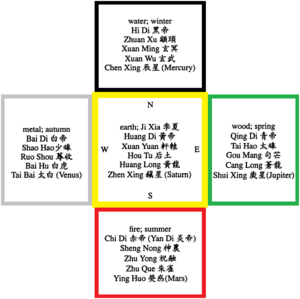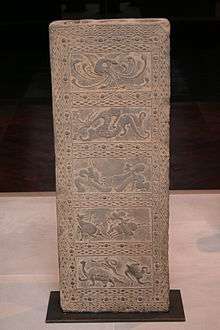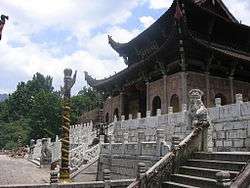Sacred Mountains of China

The Sacred Mountains of China are divided into several groups. The Five Great Mountains (simplified Chinese: 五岳; traditional Chinese: 五嶽; pinyin: Wǔyuè) refers to five of the most renowned mountains in Chinese history,[1] and they were the subjects of imperial pilgrimage by emperors throughout ages. They are associated with the absolute God and the five main cosmic deities of Chinese traditional religion. The group associated with Buddhism is referred to as the Four Sacred Mountains of Buddhism (Chinese: 四大佛教名山), and the group associated with Taoism is referred to as the Four Sacred Mountains of Taoism (Chinese: 四大道教名山).
The sacred mountains have all been important destinations for pilgrimage, the Chinese expression for pilgrimage (simplified Chinese: 朝圣; traditional Chinese: 朝聖; pinyin: cháoshèng) being a shortened version of an expression which means "paying respect to a holy mountain" (simplified Chinese: 朝拜圣山; traditional Chinese: 朝拜聖山; pinyin: cháobài shèng shān).
The Five Great Mountains


The Five Great Mountains or Wu Yue are arranged according to the five cardinal directions of Chinese geomancy, which includes the center as a direction. The grouping of the five mountains appeared during the Warring States period (475 BC - 221 BC),[3] and the term of Wu Yue (Five Summit) was made famous during the reign of Emperor Wudi of the Western Han Dynasty 140-87 BC.[1] In Chinese traditional religion they have cosmological and theological significance as they represent on the physical plane of earth the natural order emanating from the primordial God (Tian-Shangdi), inscribing and designing China as a tán 壇, "altar", the Chinese concept equivalent of the Indian mandala.
The five mountains are among the best-known natural landmarks in Chinese history, and since the early periods in Chinese history, they have been the ritual sites of imperial worship and sacrifice by various emperors.[4] The first legendary sovereigns of China went on excursions or formed processions to the summits of the Five Great Mountains. Every visit took place at the same time of the year. The excursions were hunting trips and ended in ritual offerings to the reigning god.
The emperors, starting with the First Emperor of Qin, formalized these expeditions and incorporated them into state ritual as prescribed by Confucianism. With every new dynasty, the new emperor hurried to the Five Great Mountains in order to lay claim to his newly acquired domains. Barring a number of interruptions, this imperial custom was preserved until the end of the last dynasty, when, after the fall of the Qing Dynasty in 1911, Yuan Shikai had himself crowned as emperor at the Temple of Heaven in Beijing. But just to be safe, he also made an offer to the mountain god of the northern Heng Shan.
In the 2000s formal sacrifices both in Confucian and Taoist styles have been resumed. The Five Great Mountains have become places of pilgrimage where hundreds of pilgrims gather in temples and caves. Although the Five Great Mountains are not traditionally canonized as having any exclusive religious affiliations, many of them have a strong Taoist presence,[4] thus the five mountains are also grouped by some as part of "Sacred Taoist Mountains".[5] There are also various Buddhist temples and Confucian academies built on these mountains.
Nature conservation
In ancient times mountains were places of authority and fear, ruled by dark forces and faithfully worshipped. One reason for such worship was the value of the mountains to human existence as a spring of welfare and fertility, as the birthplace of rivers, as a place where herbs and medicinal plants grew and as a source of materials to build houses and tools. A basic element of Taoist thought was, and still is, an intuitive feeling of connectedness with nature. As early as the fourth century, the Taoists presented the high priests with the 180 precepts of Lord Lao for how to live a good and honest life. Twenty of these precepts focused explicitly on the conservation of nature, while many other precepts were indirectly aimed at preventing the destruction of nature. Respect for nature has been a key component of Taoism from the very outset and, in its own right, explains why the Five Great Mountains are considered sacred. In addition, Taoists consider mountains as a means of communication between heaven and earth and as the place where immortality can be found. The sanctity of the Five Great Mountains is the reason why even today these mountains still host an exceptional diversity of plants, trees and animal species.
East Great Mountain (Dōngyuè): Tài Shān
Chinese: 泰山; "Tranquil Mountain", Shāndōng Province, 1,545 m, 36°15′N 117°06′E / 36.250°N 117.100°E
West Great Mountain (Xīyuè): Huà Shān
simplified Chinese: 华山; traditional Chinese: 華山; "Splendid Mountain", Shaanxi Province (Shănxī), 1,997 m 34°29′N 110°05′E / 34.483°N 110.083°E
South Great Mountain (Nányuè): Héng Shān (Hunan)
Chinese: 衡山; "Balancing Mountain", Húnán Province, 1,290 m, 27°15′17″N 112°39′21″E / 27.254798°N 112.655743°E
North Great Mountain (Běiyuè): Héng Shān (Shanxi)
simplified Chinese: 恒山; traditional Chinese: 恆山; "Permanent Mountain", Shānxī Province, 2,017 m, 39°40′26″N 113°44′08″E / 39.67389°N 113.73556°E
Center Great Mountain (Zhōngyuè): Sōng Shān
Chinese: 嵩山; "Lofty Mountain", Hénán Province, 1,494 m, 34°29′5″N 112°57′37″E / 34.48472°N 112.96028°E
Alternatively, these mountains are sometimes referred to by the respective directions, i.e., as the "Northern Great Mountain" (北嶽/北岳 Běi Yuè), "Southern Great Mountain" (南嶽/南岳 Nán Yuè), "Eastern Great Mountain" (東嶽/东岳 Dōng Yuè), "Western Great Mountain" (西嶽/西岳 Xī Yuè), and "Central Great Mountain" (中嶽/中岳 Zhōng Yuè).
According to Chinese mythology, the Five Great Mountains originated from the body of Pangu (盤古/盘古 Pángǔ), the first being and the creator of the world. Because of its eastern location, Mount Tài is associated with the rising sun which signifies birth and renewal. Due to this interpretation, it is often regarded as the most sacred of the Five Great Mountains. In accordance with its special position, Mount Tài is believed to have been formed out of Pangu's head. Mount Heng in Hunan is believed to be a remainder of Pangu's right arm, Mount Heng in Shanxi of his left arm, Mount Song of his belly, and Mount Hua of his feet.[6]
The Four Sacred Mountains of Buddhism

In Buddhism the Four "Sacred Mountains of China" are:[7][8][9]
Wǔtái Shān
Chinese: 五台山; "Five-Platform Mountain", Shānxī Province, 3,058 m, 39°04′45″N 113°33′53″E / 39.07917°N 113.56472°E
Wutai is the home of the Bodhisattva of wisdom, Manjusri or Wenshu (Traditional: 文殊) in Chinese.
Éméi Shān
Chinese: 峨嵋山; "High and Lofty Mountain", Sìchuān Province, 3,099 m, 29°31′11″N 103°19′57″E / 29.51972°N 103.33250°E
The patron bodhisattva of Emei is Samantabhadra, known in Chinese as Puxian (普贤菩萨).
Jiǔhuá Shān
simplified Chinese: 九华山; traditional Chinese: 九華山; "Nine Glories Mountain", Ānhuī Province, 1,341 m, 30°28′56″N 117°48′16″E / 30.48222°N 117.80444°E
Many of the mountain's shrines and temples are dedicated to Ksitigarbha (known in Chinese as Dìzàng, Chinese: 地藏, in Japanese as Jizō), who is a bodhisattva and protector of beings in hell realms
Pǔtuó Shān
Chinese: 普陀山; "Mount Potalaka (Sanskrit)", Zhèjiāng Province, 284 m 30°00′35″N 122°23′06″E / 30.00972°N 122.38500°E
This mountain is considered the bodhimanda of Avalokitesvara (Guan Yin), bodhisattva of compassion. It became a popular pilgrimage site and received imperial support in the Song Dynasty. [10]
The Four Sacred Mountains of Taoism
The "Four Sacred Mountains" of Taoism are:[7][11][12]
Wǔdāng Shān
simplified Chinese: 武当山; traditional Chinese: 武當山; literally "Military Wherewithal"; northwestern part of Hubei. Main peak: 1612m. 32°40′0″N 111°00′4″E / 32.66667°N 111.00111°E.
Lónghŭ Shān
Simplified Chinese: 龙虎山; Traditional Chinese: 龍虎山; literally "Dragon and Tiger", Jiangxi. Main peak: 247.4m. 28°06′48.999″N 116°57′29.998″E / 28.11361083°N 116.95833278°E
Qíyūn Shān
simplified Chinese: 齐云山; traditional Chinese: 齊雲山; literally "Neat Clouds", Anhui. Main peak: 585m. 29°48′29.9988″N 118°01′56.9994″E / 29.808333000°N 118.032499833°E
Qīngchéng Shān
Chinese: 青城山; literally "Misty Green City Wall"; (Nearby city: Dujiangyan, Sichuan. Main peak: 1260m (surveyed in 2007). In ancient Chinese history, Mount Qingcheng area was famous for being for "The most secluded place in China". 30°58′35.73″N 103°30′59.90″E / 30.9765917°N 103.5166389°E.
See also
- Grotto-heavens, Sacred grottoes, sometimes associated with sacred mountains
Other mountains with spiritual/religious significance in China
- Kunlun Mountains - the location of the peach tree of immortality wardened by Xiwangmu, the Queen Mother of the West
- Mount Lao
- Mount Sanqing
- Mount Lu
- Mount Changbai - regarded by Qing Manchu Emperors as the 6th Holy Mountain, above the other five, and as the source of their power
- Mount Tian - the mountain of Heaven, the most high God
Bibliography
- Sun, Xiaochun; Kistemaker, Jacob (1997). The Chinese Sky During the Han: Constellating Stars and Society. Brill. ISBN 9004107371.
References
- 1 2 Robert Hixson Julyan (1984). Mountain names. Mountaineers Books. p. 199. ISBN 9780898860917.
- ↑ Sun & Kistemaker (1997), p. 121.
- ↑ Little, Stephen and Shawn Eichman (2000). Taoism and the Arts of China. University of California Press. p. 148. ISBN 9780520227859.
- 1 2 Eberhard, Wolfram (1986). A Dictionary of Chinese Symbols: Hidden Symbols in Chinese Life and Thought. Psychology Press. p. 236. ISBN 9780415002288.
- ↑ Pregadio, Fabrizio (2008). The Encyclopedia of Taoism, Volume 1. Psychology Press. p. 1075. ISBN 9780700712007.
- ↑ Joan Qionglin Tan (2009): Han Shan, Chan Buddhism and Gary Snyder's Ecopoetic Way, Sussex Academic Press
- 1 2 Raj, Razaq and Nigel D. Morpeth (2007). Religious Tourism and Pilgrimage Festivals Management: An International Perspective. CABI. p. 108. ISBN 9781845932251.
Sacred Buddhist sites especially evidence this kind of environment, such as Mount Wutai, Mount Jiuhua, Mount Putuo and Mount Emei. The four biggest Taoist mountains – Mount Longhu, Mount Qiyun, Mount Qingcheng and Mount Wudang – are also beautiful and tranquil.
- ↑ "Sacred Buddhist Mountains in China". Alliance of Religions and Conversation.
The four sacred Buddhist mountains of China are believed to be the homes of Boddhisattvas (enlightened beings who have delayed their Nirvana to remain on earth and help others find enlightenment).
- ↑ Xi Wen. "A Visit to the Four Sacred Mountains of Buddhism". China Today.
- ↑ Bingenheimer, Marcus (2016). Island of Guanyin - Mount Putuo and its Gazetteers. London, New York: Oxford University Press. p. 16-19.
- ↑ "The "Four Sacred Taoist Mountains"". Chinese Geographical Culture.
- ↑ "Life preserving and refreshing in Wudang". China Daily. 2011-12-02.
External links
| Wikimedia Commons has media related to Five Great Mountains. |
- Google Maps Pro of 15 Sacred Mountains in China
- Google Earth Map of both Five and Four Sacred Mountains KMZ File
- Religion and the environment in China, 中国的宗教与环境 - chinadialogue article, why the five sacred mountains survive in a good ecological state
- A Report on the Nine Sacred Mountains